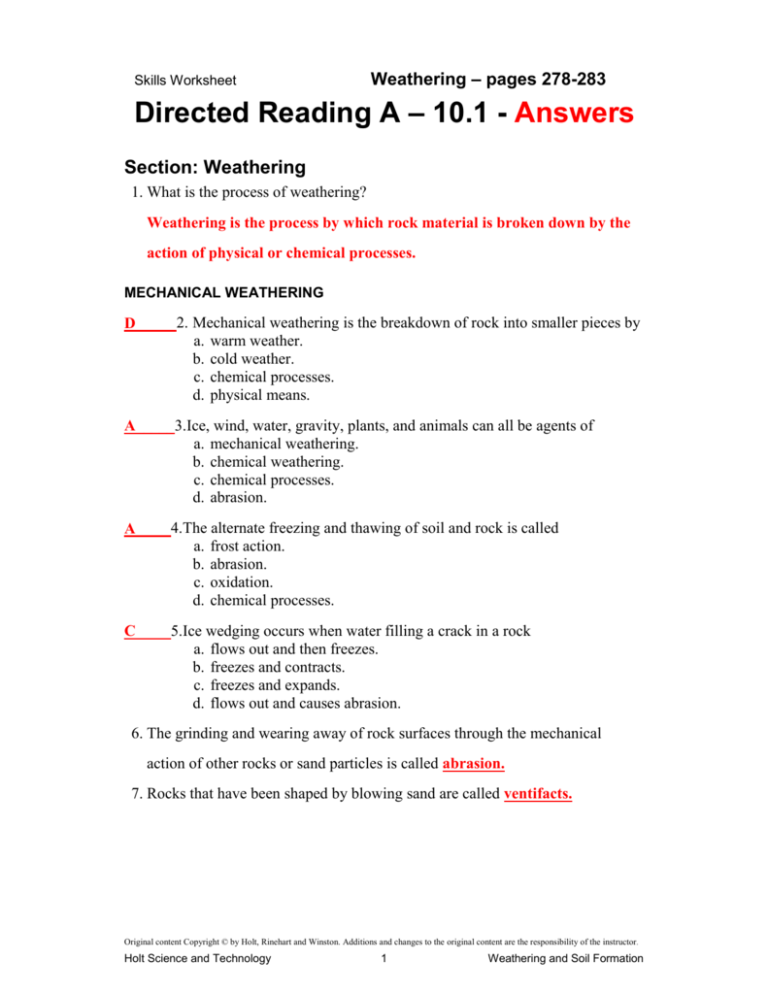Weathering Worksheet: Mechanical & Chemical Processes
advertisement

Skills Worksheet Weathering – pages 278-283 Directed Reading A – 10.1 - Answers Section: Weathering 1. What is the process of weathering? Weathering is the process by which rock material is broken down by the action of physical or chemical processes. MECHANICAL WEATHERING D 2. Mechanical weathering is the breakdown of rock into smaller pieces by a. warm weather. b. cold weather. c. chemical processes. d. physical means. A_____3.Ice, wind, water, gravity, plants, and animals can all be agents of a. mechanical weathering. b. chemical weathering. c. chemical processes. d. abrasion. A 4.The alternate freezing and thawing of soil and rock is called a. frost action. b. abrasion. c. oxidation. d. chemical processes. C 5.Ice wedging occurs when water filling a crack in a rock a. flows out and then freezes. b. freezes and contracts. c. freezes and expands. d. flows out and causes abrasion. 6. The grinding and wearing away of rock surfaces through the mechanical action of other rocks or sand particles is called abrasion. 7. Rocks that have been shaped by blowing sand are called ventifacts. Original content Copyright © by Holt, Rinehart and Winston. Additions and changes to the original content are the responsibility of the instructor. Holt Science and Technology 1 Weathering and Soil Formation Directed Reading A continued Match the correct description with the correct term. Write the letter in the space provided. B_____8.one rock falling against another rock C_____ 9. pebbles bumping against each other in a stream a. wind b. gravity c. water A_____10.wind blowing sand against rock 11. Explain how a plant can break a rock. Plant roots can grow into cracks in rocks. As the plant grows, the force of the expanding root becomes so strong, it can split the rock. 12. In what way can an animal cause mechanical weathering? An animal can cause mechanical weathering by burrowing in the soil and by moving soil particles around. CHEMICAL WEATHERING C_____13.The process by which rocks break down as a result of chemical reactions is called a. abrasion. b. mechanical weathering. c. chemical weathering. d. acid precipitation. B_____14.Rain, sleet, or snow that contains a high concentration of acids is called a. mechanical weathering. b. acid precipitation. c. chemical weathering. d. abrasion. D_____15.Compounds formed by the burning of fossil fuels combine with water in the atmosphere to form a. phosphoric acids. b. acetic acids. c. carbon monoxide. d. weak acids. Original content Copyright © by Holt, Rinehart and Winston. Additions and changes to the original content are the responsibility of the instructor. Holt Science and Technology 2 Weathering and Soil Formation Directed Reading A continued C_____16.Acid precipitation can result from a. ventifacts. b. abrasion. c. burning of fossil fuels. d. mechanical weathering. 17. Over a long period of time, acids in the groundwater can cause chemical weathering of limestone. This weathering can form a cavern, which is a type of karst features. 18. Explain how lichens cause chemical weathering. Lichens grow on rocks. They produce acids that can slowly break down rocks. 19. The chemical reaction in which an element, such as iron, combines with oxygen to form an oxide is called oxication. 20. When oxygen in the air reacts with metal, oxidation occurs and causes the metal to rust. Original content Copyright © by Holt, Rinehart and Winston. Additions and changes to the original content are the responsibility of the instructor. Holt Science and Technology 3 Weathering and Soil Formation






